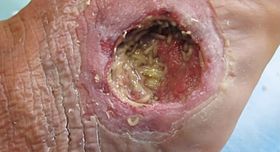Maggot therapy
| Maggot therapy | |
|---|---|
| Intervention | |

Maggot debridement therapy on a wound on a diabetic foot
|
|
| Synonyms | maggot debridement therapy (MDT), larval therapy, larva therapy, larvae therapy, biodebridement, biosurgery |
Maggot therapy is a type of biotherapy involving the introduction of live, disinfected maggots (fly larvae) into the non-healing skin and soft tissue wound(s) of a human or animal for the purpose of cleaning out the necrotic (dead) tissue within a wound (debridement) and disinfection.
There is evidence that maggot therapy may help with wound healing.
Maggot therapy improves healing in chronic ulcers.
In diabetic foot ulcers there is tentative evidence of benefit.
In 2004, the FDA cleared maggots for use as a medical device in the United States for the purpose of treatment of:
The wound must be of a type which can benefit from the application of maggot therapy. A moist, exudating wound with sufficient oxygen supply is a prerequisite. Not all wound-types are suitable: wounds which are dry, or open wounds of body cavities do not provide a good environment for maggots to feed. In some cases it may be possible to make a dry wound suitable for larval therapy by moistening it with saline soaks, applied for 48 hours.
Patients and doctors may find maggots distasteful, although studies have shown that this does not cause patients to refuse the offer of maggot therapy. Maggots can be enclosed in opaque polymer bags to hide them from sight. Dressings must be designed to prevent any maggots from escaping, while allowing air to get to the maggots. Dressings are also designed to minimize the uncomfortable tickling sensation that the maggots often cause.
The maggots have 4 principal actions:
In maggot therapy, large numbers of small maggots consume necrotic tissue far more precisely than is possible in a normal surgical operation, and can debride a wound in a day or two. The area of a wound's surface is typically increased with the use of maggots due to the undebrided surface not revealing the actual underlying size of the wound. They derive nutrients through a process known as "extracorporeal digestion" by secreting a broad spectrum of proteolytic enzymes that liquefy necrotic tissue, and absorb the semi-liquid result within a few days. In an optimum wound environment maggots molt twice, increasing in length from 1–2 mm to 8–10 mm, and in girth, within a period of 48–72 hours by ingesting necrotic tissue, leaving a clean wound free of necrotic tissue when they are removed.
...
Wikipedia
